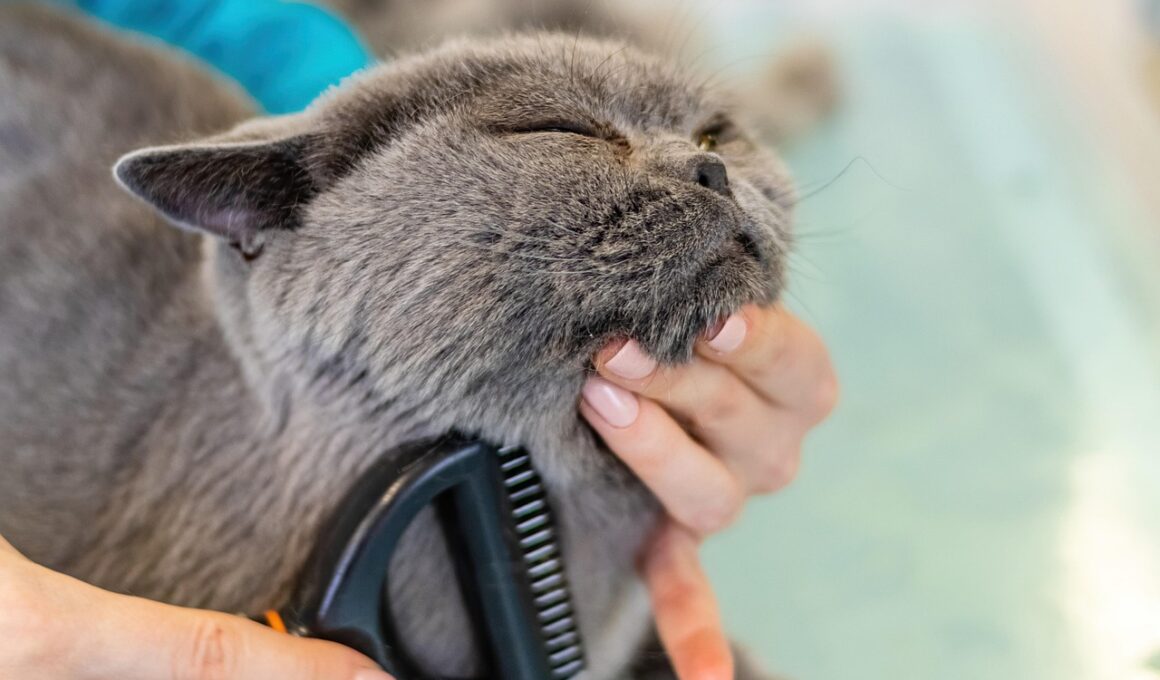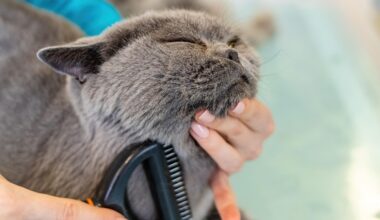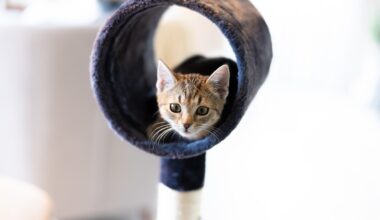Preventing Common Grooming Challenges Through Long-Term Planning
Grooming cats is an essential aspect of pet ownership that often gets overlooked. The significance of a long-term grooming plan lies in its ability to address common grooming challenges before they escalate into more serious issues. Regular grooming not only keeps your cat looking its best but also helps to maintain their overall health. Implementing a structured grooming routine can also reduce shedding, hairballs, and skin problems. By forming a positive association with grooming from an early age, your cat will likely become more cooperative and less stressed during sessions. Common tools required include brushes, combs, and nail clippers, all of which can be tailored to your specific cat’s needs. Additionally, early attention to knots or mats can alleviate discomfort and prevent potential pain later. Regularly scheduled grooming appointments, whether at home or with a professional groomer, can also benefit both you and your furry companion. Establish a timeline to assess your cat’s grooming situation, making adjustments as necessary. Overall, maintaining consistent grooming practices forms a strong foundation for a healthy and happy pet.
Preventing health problems in cats is another vital aspect associated with grooming. By addressing grooming needs promptly, owners can help to identify potential health issues that may go unnoticed. Cats often hide discomfort, or illness, making it essential for owners to stay vigilant. During grooming sessions, check for signs of skin irritation, lumps, or parasites. Keeping your cat clean and well-groomed decreases susceptible areas for bacteria and parasites to thrive. Regular brushing keeps the coat clean, reduces shedding, and distributes natural oils, promoting healthy skin. This proactive approach allows you to identify problems, vastly improving the chances of successful treatments. Long-term grooming plans should also set you up to handle various seasonal changes, including shedding periods and weather effects on their coat. For instance, during summer, you may need to budget extra time for grooming due to increased shedding. Engage in open communication with your veterinarian regarding regular check-ups alongside grooming to ensure overall health and wellness. They can recommend suitable grooming tools and techniques based on the specifics of your cat’s breed and individual needs, contributing to a comprehensive care strategy.
Creating a Customized Grooming Schedule
A customized grooming schedule tailored to your cat’s unique needs can prevent common challenges. Factors include their breed, age, and specific temperament. Long-haired breeds may require more frequent grooming to prevent mats and tangles, while short-haired cats may be fine with less frequent attention. Take the time to observe your cat’s response during each session; some may resist grooming due to sensitivity. Therefore, adapting your approach based on their reactions can drastically improve the experience. Incorporate varied brushes and tools to cater to their fur type, enhancing comfort and efficiency. When planning the grooming session, prepare a checklist of priorities focusing on essential tasks. For instance, if nail trimming is challenging, consider focusing on nail care every third grooming appointment so that it does not become overwhelming for your feline friend. Setting aside 10-15 minutes several times a week often makes a difference in your cat’s grooming experience. Transitioning your cat into grooming gradually and making it enjoyable through treats can significantly enhance cooperation levels throughout your grooming journey.
Common challenges include shedding, mats, and nail care. Shedding can become excessive without a consistent grooming routine, leading to frustrations for owners and even allergies for some. Handling fur balls can easily disseminate to other areas of the home. Effective use of adhesives, like lint rollers, can assist in keeping your space clean. Also, recognizing and identifying signs of significant shedding may prompt health assessments to ensure your cat’s well-being. Mats and tangles often develop in long-haired breeds and can also induce pain or discomfort if left unattended. Establishing a specific grooming schedule minimizes mat development significantly and could limit the necessity for professional grooming. When addressing nail care, it’s essential to acclimate your cat to these sessions early on for ease of handling and comfort. Consider using specialized nail clippers designed for pets to avoid injury. Establish a routine rewards system that promotes positive reinforcement to make the grooming experience enjoyable while preventing resistance. By balancing a comprehensive approach to grooming, owners can reduce frustrations, ensure hygiene, and strengthen their bond with their cats.
Choosing the Right Grooming Products
Selecting the appropriate grooming products is crucial for the effective implementation of your long-term grooming plan. Different products serve variable purposes, and it’s important to understand which tools suit your cat’s specific needs. Consider factors like fur type, sensitivity, and personality traits. Soft-bristled brushes work well for sensitive skin, whereas stiffer options may be suitable for harder purposes, such as dematting. Choosing high-quality products designed for cats enhances grooming safety and effectiveness. If your cat tends to resist brushing, opt for detangling sprays or grooming gloves that may feel less invasive. Regular maintenance of grooming tools by keeping them clean and functional elevates the whole grooming experience. Ensure any clippers or scissors used are sharp and designed for feline care to avoid injury during the sessions. It’s also wise to consult with your veterinarian on recommended products for your cat, ensuring compatibility with their unique needs. Investing in high-quality grooming products not only promotes efficiency during sessions but also enhances your cat’s response, creating a more enjoyable experience for both the owner and the pet.
Incorporating regular check-ins with a veterinarian supports a long-term grooming strategy aligned with health insights. Vets can advise on grooming frequency, essential product recommendations, and potential health issues that may arise in certain breeds. This alignment prepares owners for unexpected health changes that might affect grooming requirements, avoiding common challenges. Regular vet visits also enable you to collect timely vaccinations and administer treatments as needed, including antiparasitics, which could significantly affect grooming. In addition to the vet’s insights, consider building a network of professional groomers who can provide advice on best practices and establish accountability as well. Setting up an emergency plan for when health challenges arise can help you remain proactive in maintaining your cat’s grooming needs. Include trusted pet sitters or groomers in this plan in the event of hospitalization or travel. Long-term grooming requires support from various sources to remain sustainable and effective over time. Emphasizing this balance leads to a smoother grooming experience where you learn as you go while ensuring your cat’s health is always a top priority.
Creating Positive Associations with Grooming
Building positive associations with grooming can make all the difference. Regular contact with your cat during grooming can foster trust and reduce anxiety. Consider introducing grooming tools slowly, allowing your cats to explore them at their own pace. During sessions, maintain a calm tone of voice and occasional treats, integrating short intervals to keep their attention. Over time, short, consistent grooming sessions can encourage familiarity with various products and tools. It is essential to monitor your cat’s behavior and engage with cues indicating stress. Establish a routine by grooming the same time each day or week, becoming a predictable experience. Additionally, interactive play sessions can serve as productive breaks, which can also smoothen transitions between grooming tasks. Celebrate small victories, like successfully brushing a tricky spot, with praise or treats, reinforcing good behavior. If your cat shows resistance, take a step back and reassess your approach, adjusting as needed to accommodate their comfort. A positive grooming experience enhances your bond with your pet, instills trust, and leads to a more manageable grooming process over the long term.
Ultimately, a long-term grooming plan is a comprehensive and dynamic strategy that evolves alongside your cat’s needs. It’s developed with keen observation, preventive measures, and trusted resources from both professionals and veterinarians. As cats age, their grooming requirements may shift; thus, remaining receptive and adaptable is key. Periodic reevaluation of your grooming plan ensures it aligns with your pet’s health, comfort, and preferences. The network of specialists developed during this journey can lend support in navigating this learning experience, guiding you towards best practices while addressing specific challenges. Asking for recommendations and gathering experience from other cat owners may provide additional insights, leading to valuable techniques that work well. Moreover, conducting routine checks that reinforce positive associations and proper grooming techniques can promote a smoother process. This also leads to shared sessions with friends and family becoming less daunting. Investing in your cat’s grooming needs enhances their quality of life, ensuring they remain healthy, happy, and well-adjusted. Overall, maintaining a comprehensive approach to grooming is integral to not only preserving your cat’s appearance but also to nurturing a harmonious owner-pet relationship.


